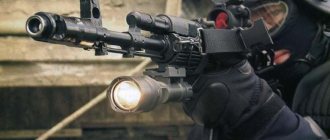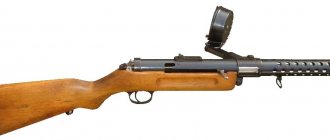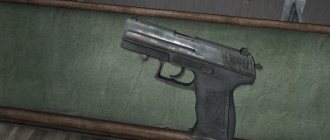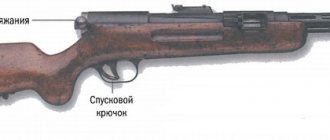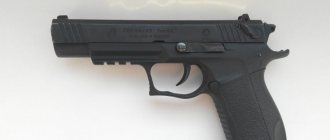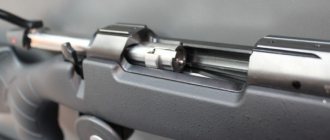The Kedr submachine gun is a small-sized machine gun for the needs of the Ministry of Internal Affairs, which would later receive its official name in 1991, shortly before the collapse of the USSR. Refinement of weapons was already underway in the Russian Federation. Only in 1993, the Kedr submachine gun was adopted by the country's law enforcement agencies and mass production was launched at the Zlatoust Mining Plant.
It seems that the PP-91 was created quickly, but in fact the design used the developments of the PP-17, which at one time was designed by the famous gunsmith Evgeniy Dragunov. At that time, the weapon was not accepted for service, but in the new realities of the Russian Federation it appeared on time. The weapon was named after the designer - “Cedar” (designed by Evgeny Dragunov).
History of creation
After the adoption of the AK-47 and the curtailment of production of all wartime submachine guns and the 7.62 mm TT cartridge, such a class as PP was temporarily forgotten. Although sometimes attempts were made to create. This is how the Stechkin automatic pistol, which is used by the military today, was developed and put into production. However, APS became rather an exception to the rule.
Towards the end of the 1960s, the army came to the conclusion that compact automatic weapons were needed for the work of special forces of the SA and the Navy. It was they who initiated and promoted the “Bouquet” competition, during which the USSR Design Bureau sent their samples. Unexpectedly, law enforcement agencies, the KGB and the Ministry of Internal Affairs, who also needed weapons to work in cramped conditions, showed interest in the program.
Several design bureaus participated in “Bouquet”. Among them, the eminent gunsmith designer Evgeny Dragunov, who at that time created his own SVD rifle, presented his work. Evgeniy Fedorovich presented his PP-71 submachine gun to the commission (later it will form the basis of the Russian PP Kedr assault rifle). After all the tests, the army abandoned the results of the competition. The main argument was that the power of the ammunition was too low. This is logical, because the PM cartridge was not created for army needs.
The most interesting thing is that the army did not abandon the concept of a compact machine gun. Later, after the AK-74 is put into service, the development of the AKS-74U will begin.
At the same time, civilian security forces did not accept the PP-71 precisely because of the excessive power of the shot. In those years, special low-power cartridges with a low probability of rebound had not yet been developed for the PM. All of Dragunov’s achievements were shelved and will be remembered only towards the end of the Soviet Union.
E. Dragunov's developments are being implemented in PP-91
In the 1980s, the army and police began to receive shortened versions of the AK-74 with a folding stock, an offset bolt group and a reduced barrel length. AKS-47U (AKSU) turned out to be relatively convenient and unpretentious. At the same time, the machine used a regular 5.45x39 mm cartridge. The ammunition is powerful and therefore security forces rarely used AKSU in crowded places. Therefore, they needed less powerful automatic weapons. This became the reason for a series of developments of a new submachine gun chambered for the 9 mm cartridge.
The beginning of the 1990s generally became rich in weapons of this category. In those years, a significant number of submachine guns in modern Russia appeared. Not all of them went into production, but many provided experience. Which was later embodied in more successful models.
In 1991, work officially began on the Kedr 91. This type of weapon took a lot from the PP-71, but a number of changes were made to the design related to the developments of the past years and the development of science and technology. The designers partially redesigned the automation, added more polymer elements and increased the reliability of the design. "Kedr" is designed to fire 9mm PM cartridges, but cannot fire 9x18mm PMM. Its chamber and bolt group simply cannot withstand it.
The first pre-production products were assembled at IzhMash. They were the ones who passed all the trials and tests prepared by the commission. During testing, almost no changes were made to the design of the machine gun. But the engineers took into account the wishes of the receiving party, modified the weapon, and in 1994 the PP-91 was put into production at the Zlatoust Mining Plant.
Operation of PP 91
The main idea of creating a machine gun was to provide the various law enforcement agencies of the Russian Federation with modern, reliable and simple weapons. The PP 91 submachine gun meets all the requirements stated during the competition and is now in service with all special forces in the country. For the needs of security companies, a model with automatic fire disabled and standard 9x17 mm ammunition has been developed. Some of the products are actively sold abroad, where the machine gun is popular due to the combination of performance characteristics and price.
Photo PP-90M
Similar
AK-47 assault rifle cartridge caliber 7.62 mm. Device. Rate of fire
AK-74 assault rifle cartridge caliber 5.45 mm. Device. Rate of fire
Dragunov SVD sniper rifle caliber 7.62 mm. Device
AKS-74U assault rifle cartridge caliber 5.45 mm. Device. Weight
Mauser K96 pistol cartridge caliber 7.63 and 9 mm. Device
Pistol Walter PP / PPK cartridge caliber 7.65 and 9 mm. Device
Pistol Yarygin PYa Grach cartridge caliber 9 mm. Device
DShK machine gun cartridge caliber 12.7 mm. Device. Rate of fire
Luger pistol R.08 Parabellum cartridge caliber 9 mm. Device
Pistol PM cartridge caliber 9 mm. Rate of fire. Dimensions. Bullet speed. Sighting range
Self-loading shotgun Saiga-12 cartridge, caliber. Device
Maxim machine gun cartridge caliber 7.62 mm. Device. Weight
PPSh-41 Shpagina submachine gun cartridge caliber 7.62 mm
APS Stechkin pistol cartridge caliber 9 mm. Device
Nagan system revolver cartridge caliber 7.62 mm. Device
Kalashnikov PK machine gun and PKM cartridge caliber 7.62 mm. Device
Simonov carbine SKS-45 cartridge caliber 7.62 mm. Device
Rifles and carbines Mauser 98 caliber 7.92 mm. Device
PPS-42 and PPS-43 Sudaev submachine gun cartridge caliber 7.62 mm
Pistol Walter P38 cartridge caliber 9 mm. Device
MP-40 German submachine gun cartridge caliber 9 mm. Device
VSS Vintorez sniper rifle caliber 9 mm. Device
Submachine gun PP-91 Kedr cartridge 9 mm caliber. Device
Light machine gun RPK-74 cartridge caliber 5.45 mm. Device
Pistol Glock 17 cartridge caliber 9 mm. Device
Makarych, Izh-79-9T, MR-79-9TM, MP-80-13T traumatic pistol
AK-12 assault rifle cartridge caliber 5.45 mm. Device. Weight
Mosin rifles and carbines Three-line caliber 7.62 mm
PMM Makarov pistol modernized 12 rounds. Device
Revolver Colt Single Action Army (SAA) Peacemaker. Device
Machine gun PKP Pecheneg cartridge caliber 7.62 mm. Device
Sniper rifle VSSK Exhaust caliber 12.7 mm. Device
Beretta pistol 92 cartridge caliber 9 mm. Device
TT - Tokarev pistol cartridge caliber 7.62 mm. Device
Submachine gun PP-19 Bison cartridge caliber 9 and 7.62 mm. Device
Sniper rifle SV-98 caliber 7.62 mm. Device
Vladimirov KPV machine gun cartridge caliber 14.5 mm. Device
ASH-12 assault rifle cartridge caliber 12.7 mm. Device. Rate of fire
PSM pistol cartridge caliber 5.45 mm. Device
Pistol Colt M1911A1 cartridge caliber 45. Device
Smith-Wesson revolver Russian cartridge, caliber 10.67 mm. Device
Degtyarev DP-27 light machine gun, 7.62 mm caliber cartridge. Device
Shotgun Mossberg 500 Cartridge. Dimensions. Rate of fire. Sighting range
Pistol USP Heckler und Koch cartridge, caliber. Device
Thompson submachine gun cartridge caliber 11.43 mm. Device
Hunting carbine OSK-88 (SVT-40) caliber 7.62 mm. Device
AS Val silent automatic cartridge caliber 9 mm. Device
Submachine gun PP-19-01 Vityaz cartridge 9 mm caliber. Device
Machine gun Kord cartridge caliber 12.7 mm. Device. Weight. Sighting range
Osa - traumatic pistol cartridge, caliber. Device
AK-9 assault rifle cartridge caliber 9 mm. Device. Rate of fire
Degtyarev RPD light machine gun, 7.62 mm caliber cartridge. Device
Automatic OTs-14 Groza cartridge caliber 9 mm and 7.62 mm. Device
Czech pistol CZ-75 (modifications). Device
Browning pistol 1903 cartridge caliber 9 mm. Device
Sniper rifle OSV-96 caliber 12.7 mm. Device
FN P90 submachine gun cartridge caliber 5.7 mm. Device
Submachine gun OTs-02 Cypress cartridge caliber 9 mm. Device
Sniper rifle ASVK Kord caliber 12.7 mm. Device
Automatic AEK-971 Cartridge. Caliber. Device. Rate of fire
Steyr AUG assault rifle (A1, A2, A3) cartridge caliber 5.56 mm
AK series 100 assault rifles. Modifications. Device. Weight. Dimensions
Uzi submachine gun. Cartridge. Caliber. Rate of fire
Pistol SR1M Gyurza cartridge caliber 9 mm. Device
Pistol GSh-18 cartridge caliber 9 mm. Device
SVDK sniper rifle caliber 9.3 mm. Device
Automatic SR-3M Whirlwind cartridge caliber 9 mm. Device
Machine gun NSV-12.7 Utes cartridge, cal. Device. Weight
Kalashnikov RPK light machine gun cartridge caliber 7.62 mm. Device
Sniper rifle VSK-94 caliber 9 mm. Device
Vostok-1 (Jorge-3M) 9mm caliber traumatic pistol. Device
Degtyarev PPD submachine gun cartridge caliber 7.62 mm
English sniper rifle L96A1 cartridge, caliber
M1 Garand rifle cartridge caliber 7.62 mm. Device
Desert Eagle pistol. Device
Smith-Wesson revolver (modifications). Device
Automatic rifle HK G36 (E, K, C, KE) cartridge caliber 5.56 mm
Pistol P-96 cartridge caliber 9 mm. Device. Rate of fire
Pistol GP35 Browning High Power cartridge, caliber. Device
Assault rifle FN SCAR (L, H) cartridge caliber 5.56 and 7.62 mm
Revolver Lefoshe M1856 cartridge caliber 11 mm. Device
Submachine gun PP-90 cartridge caliber 9 mm. Device
AN-94 Abakan automatic Nikonov cartridge caliber 5.45 mm. Device
Submachine gun PP-2000 cartridge caliber 9 mm. Device
Mauser pistol HSc cartridge caliber 7.65 and 9 mm. Device
M16 automatic rifle cartridge caliber 5.56 mm. Device
Fedorov assault rifle cartridge caliber 6.5 mm. Device. Rate of fire
Pistol Baltiets cartridge caliber 7.62 mm. Device
Strizh pistol cartridge caliber 9 mm. Device. Weight. Sighting range
Browning pistol 1910 cartridge caliber 7.65 and 9 mm
Silent pistol PSS Vul cartridge caliber 7.62 mm. Device
Pistol SIG-Sauer P226 cartridge caliber 9 mm. Device
Pistol OTs-27 Berdysh cartridge caliber 7.62 mm and 9 mm. Device
AK-107 assault rifle cartridge caliber 5.45 mm. Device. Rate of fire
OTs-44 sniper rifle, caliber 12.7 mm. Device
German machine gun MG3 cartridge caliber 7.62 mm. Device
Self-loading shotgun Browning Auto-5 cartridge, caliber. Device
Submachine gun AEK-919K Kashtan cartridge caliber 9 mm. Device
PB pistol silent cartridge 9 mm caliber. Device
Pistol OTs-33 Pernach cartridge caliber 9 mm. Device
Hunting carbine KO-98 cartridge caliber 7.92 mm. Device
TK (Korovin pistol) caliber 6.35 mm. Device. Weight. Dimensions
Underwater assault rifle APS cartridge caliber 5.66 mm. Device
Pistol OTs-21 Malysh cartridge caliber 9 mm. Device
American M60 machine gun, 7.62 mm caliber cartridge. Device
MTs-116M sniper rifle, caliber 7.62 mm. Device
Automatic 9A-91 cartridge caliber 9 mm. Device. Rate of fire
Submachine gun PP-93 cartridge caliber 9 mm. Device
VAG-73 - Gerasimenko pistol. Device. Weight. Dimensions
Cordon-5 is a traumatic pistol. Device. Weight. Dimensions
Goryunov SG-43 heavy machine gun cartridge caliber 7.62 mm. Device
Webley revolver cartridge, caliber. Device. Dimensions. Weight
Machine gun AEK-999 Badger cartridge caliber 7.62 mm. Device
RP-46 machine gun, 7.62 mm caliber cartridge. Device. Rate of fire
Sniper rifle VS-8 cartridge caliber 8.6 mm. Device
Slostin machine gun cartridge caliber 7.62 mm and 14.5 mm. Device
Assault rifle Tavor TAR-21 cartridge caliber 5.56 and 5.45 mm
Submachine gun SR-2 Veresk cartridge caliber 9 mm. Device
Lancaster pistol cartridge caliber 12.1 mm. Device. Rate of fire
Submachine gun PP-90M1 cartridge caliber 9 mm. Device
Underwater pistol SPP-1M. Device. Weight. Dimensions
Traumatic pistol MP-461 Guard. Device. Weight. Dimensions
Lebel rifles and carbines are cartridgeed in 8 mm caliber. Device
Automatic A-91 cartridge caliber 7.62 mm. Device. Rate of fire
M14 automatic rifle cartridge caliber 7.62 mm. Device
Revolver Smith & Wesson Model 10 Military & Police
Automatic rifle FN FAL cartridge caliber 7.62 mm. Device
Submachine gun STEN MK 2. Device. Weight. Dimensions
Traumatic pistol IZH-78-9T Chain mail cartridge caliber 9 mm
Leader-M traumatic pistol 11.43×32T. Device. Weight. Dimensions
Ingram M10 and M11 submachine gun. Device. Weight. Dimensions
Pistol Steyr M9-A1 cartridge caliber 9 mm. Device. Weight
Pistol OTs-23 Dart cartridge caliber 5.45 mm. Device
Berthier rifles and carbines caliber 8 mm. Device
Automatic shotgun USAS-12 cartridge caliber 18.5 mm
Sniper rifle VS-121 caliber 7.62 mm. Device
Traumatic pistol MP-353 cartridge, caliber 11.43 mm
Tiss machine gun cartridge caliber 9 mm. Device. Rate of fire
Traumatic pistol MP-355 cartridge caliber 9 mm. Device
Automatic double-medium ADS cartridge caliber 5.45 mm. Device. Rate of fire
Traumatic pistol MP-81 cartridge caliber 9 mm. Device
Pistols Zastava 70 and 70(k), cartridge caliber 7.65 or 9 mm. Yugoslavia
Sniper rifle GALATZ (Galil) cartridge caliber 7.62 mm
Pistol MP-444 Bagheera cartridge caliber 9 mm. Device
Revolver Colt New Army / Navy. Device. Bullet speed. Sighting range
Type 64 is a Japanese automatic rifle. Device
Description of the design and features of the device
Dragunov created his submachine gun primarily for the Soviet army, which means that his extremely simple design is combined with high technology. The Russian submachine gun PP 91 Kedr has retained these qualities. The machine gun is almost entirely assembled from steel parts, and the receiver is made by stamping. The only plastic elements of the weapon are the pistol grip cheeks and the back of the shoulder rest.
PP 91 “Kedr” by Evgeniy Dragunov – submachine gun
The receiver is rectangular in shape with a cover that can be removed from above for quick access to the weapon mechanisms and partial disassembly. It also houses sighting devices in the form of a rear sight and a front sight, as well as a mount for the shoulder rest, which, in the stowed position, folds up and forward, resting on the receiver. Near the muzzle there is a mount for a muffler. A laser target designator is also installed on the SC.
A box magazine shaft was placed on the lower part of the vehicle. There are two magazine options: 20 and 30 rounds. At the same time, during concealed carry, a clip of 20 rounds is always equipped. In one version of the model, the magazine shaft is moved to the handle.
Kedr is a submachine gun, not distinguished by any frills in automation. It is all built on the principle of free movement of the bolt under the action of powder gas after a shot. When firing, the bolt moves to its rearmost position, removing the cartridge case from the chamber, compressing the return spring and cocking the hammer. It then rolls back under the influence of the spring, snatches a fresh cartridge from the magazine and locks the chamber. Interestingly, there are no additional devices for locking and the bolt is held only by the forces of the spring.
For safe wearing, the product is installed with a safety lock. The part is made in the form of a flag and at the same time serves as a fire translator. The model can fire single and burst.
Submachine guns Kedr and Klin
Klin
and
Cedar
. The PP-71 prototype was created by Evgeny Dragunov in the late 60s, which is reflected in the name (KEDR - Design by Evgeny Dragunov). “Kedr” was developed in Russia at the Izhevsk Mechanical Plant by the eldest son of E. F. Dragunov, Mikhail Dragunov.
The weapon is designed for the 9x18 mm cartridge from the Makarov pistol. In 1994, a modification appeared called “Wedge”, created for the high-pulse 9x18 mm PMM cartridge. The automatic PP operates by using the recoil energy of the free shutter; the shot occurs when the shutter is unlocked. Unusual for a small-sized PP is the use of a trigger-type firing mechanism. Thus, the shot occurs with the bolt fully closed, although it is not locked onto the lugs (the so-called shooting “from the rear sear”). The receiver is rectangular, stamped, and has a removable cover. The 120 mm long barrel is rigidly attached to the receiver, to which are attached a pistol grip, a magazine receiver and a folding stock. In addition, the submachine gun has six more large components (parts) into which it can be disassembled without the use of tools: a magazine, a receiver cover, a return spring with a guide, a bolt, a trigger mechanism and a safety switch. The reloading handle is located on the left side of the bolt, is made as one piece with the bolt body and moves with it during firing. The safety switch is located on the right side of the receiver. In the lowest position, it blocks the sear, and the stop enters the body of the bolt and holds it in the rearmost position. In the middle position of the translator, a single fire is possible, in the uppermost position - continuous. Sights PP open type. The front sight is mounted on the barrel at the front wall of the receiver, the rear sight is mounted on top of the folding stock attachment point. When the butt is folded, the rear sight faces the shooter with a rectangular slot; when the butt is folded back, it automatically flips over to the diopter hole. The accuracy of firing PP with single shots at a distance of 25 meters is no worse than 50 mm. A silencer and a laser target designator can be mounted on the weapon. The Klin submachine gun chambered for the modernized 9x18 mm cartridge differs only slightly. The increased energy of the cartridge required measures to reduce the rate of fire. This is achieved by increasing the mass of the bolt and the use of Rivelli spiral grooves in the chamber, which increase resistance during case extraction and thereby increase the time of case extraction and bolt movement. There are other minor changes, in particular, the safety switch has been moved to the left side of the receiver. The weapon can also be fired with standard 9x18 cartridges, but the rate of fire is noticeably reduced. The bullet of the modernized cartridge penetrates a 3-mm steel plate at a distance of 20 meters while maintaining its lethal effect behind an obstacle.
The barrel of both SMGs has four right-hand rifling with a pitch of 240 mm. The PP Klin can use 9x18 PMM cartridges, for which the barrel is moved forward by 2 mm to facilitate feeding the PMM cartridge, which has a conical bullet, into the chamber. At the same time, the increased recoil energy required measures to reduce the rate of fire. This is achieved by increasing the mass of the bolt and applying helical grooves in the chamber, which increase the resistance when extracting the cartridge case, and therefore the time of movement of the bolt. There are other changes. The target firing range is 25 m. Effective range is 50 m, Wedge is 100 m. Barrel life is 4000 rounds, two firing modes are automatic/single. It is in service with special forces of internal affairs bodies and units of the Internal Troops of the Ministry of Internal Affairs of the Russian Federation. By its design, “Kedr” refers to a weapon that works on the principle of using the recoil energy of a free bolt. Trigger mechanism of hammer type. The location of the hammer axis, the mainspring stop pins and the mainspring guide stop on the hammer are selected in such a way that at the end of cocking the hammer, the force of the mainspring creates a moment that causes the hammer to be pressed away from the bolt. In this case, a guaranteed gap is created between the bolt and the trigger, eliminating friction losses during most of the work cycle. The safety switch, when installed in the “safety” position, blocks the trigger and pushes the bolt stop into a groove on the lower plane of the bolt, thereby preventing overloading when the safety is on. The switch-safety flag in this position partially extends into the hole for the index finger formed by the trigger guard, which allows you to determine by touch in the dark whether the sample is ready to fire. When the translator is in the middle position, single shooting is ensured, in the uppermost position - automatic shooting. After all the cartridges are used up, the magazine feeder raises the stop, which locks the bolt in the rear position. The sample uses a combined rear sight, which automatically switches when the butt is moved from the traveling position to the combat position and back. When the stock is folded down, the rear sight shield with diopter rises; when folded, the rear sight shield with a slot rises. This ensures ease of aiming both when shooting from an outstretched arm, and with the butt resting on the shoulder. The sample is distinguished by good accuracy both during single and automatic shooting. At a distance of 25 m, a circle with a radius of 5 cm contains 100% of hits when firing single shots and 50% when shooting in short bursts, which ensures a guaranteed hit of the target with the first shot (or the first burst) at close combat range. Despite the relatively high rate of fire (up to 1000 rounds per minute), it fires in short bursts of 3-4 shots. The design of the "Kedr" served as the basis for the creation of a submachine gun chambered for a modernized 9-mm high-impulse cartridge with a high muzzle velocity. Thanks to the new cartridge, the effectiveness of the submachine gun, called “Wedge,” has significantly increased. The penetration effect at a distance of 20 m has increased; the bullet of the modernized cartridge penetrates a steel sheet 3 mm thick. The accuracy of fire has been significantly improved: at a distance of 150 m, the transverse dispersion during single shooting is less than 80 cm. The standard cartridge at the same range has a dispersion of more than 200 cm. The flatness of the bullet of the modernized 9-mm cartridge allows shooting up to 150 m with a constant sight setting. Despite all the advantages of the new cartridge, the submachine gun also provides reliable operation with standard 9 mm cartridges. When creating the Klin submachine gun, the basic design solutions of the Kedr submachine gun were retained, ensuring its high combat and performance qualities: a trigger mechanism with a break in contact between the hammer and the bolt, a combined sighting device, a safety lock that blocks when the trigger is turned off hook and bolt. A characteristic feature of the sample is the ability to fire both 9-mm high-impulse cartridges and standard cartridges for the Makarov pistol. This is ensured by guide elements in the receiver and a special chamber design, developed by specialists from the Izhevsk Mechanical Plant for the modernized Makarov pistol. The methods of disassembly, assembly and maintenance are completely identical to those of the Kedr submachine gun. The production of the experimental series of Klin submachine guns began in 1994 at the Zlatoust Machine-Building Plant production association. Based on the Kedr, a modification with a Kedr-B silencer was also developed, unified with it and the Klin submachine gun. To reduce the sound of a shot, the barrel is equipped with 5 rows of holes (2 in a row), which are covered with a roll of stainless steel mesh. The muffler consists of an expansion chamber (inside which there is a roll) and a nozzle connected to it with diaphragms inside. To reduce the size, the attachments can be separated when worn. If it is necessary to instantly target a target in conditions of limited visibility, a laser target designator is used. It allows you to confidently hit targets offhand and, in addition, has a powerful psychological effect on the enemy. Its normal operation is ensured at temperatures from minus 20 to plus 40 degrees Celsius. For concealed carry, a pendant is provided that allows you to carry a submachine gun under outer clothing without attracting the attention of others. The suspension ensures reliable fixation of the weapon and almost instantaneous removal. The complex of automatic weapons chambered for the 9-mm pistol cartridge, created by Izhevsk designers, is one of the best among modern submachine guns in terms of its main tactical and technical characteristics.
Partial disassembly of the Klin software:
- press the magazine release and remove it from the receiver;
- Move the safety catch down, move the bolt to the rearmost position, check the discharge, release the bolt, pull the trigger;
- turn the receiver cover latch 90 degrees, lift the rear end of the cover and pull it back;
- press forward the base of the return spring guide rod, lift and turn 180 degrees, remove the guide rod with the return spring;
- move the shutter to the rear position and lift it up;
- set the translator-safety flag to a vertical position and remove it to the right side;
- lift the front end of the trigger mechanism body and move the trunnions forward and upward from the grooves of the receiver, turn the mechanism along the axis and remove it upward.
the Klin-2 submachine gun
- a new word in the history of domestic design. The main feature of Klin-2 is the use of so-called balanced automation, that is, the principle of reducing the recoil impulse by creating a dynamic torque with a value reciprocal to the recoil impulse. This is achieved using synchronous and opposite movement of two inertial masses. In the design of Klin-2, the role of these two masses is performed by the movable barrel and the bolt frame. When fired, a recoil moment is created, causing the bolt group to roll back to the rear wall of the receiver. At the same moment, following the movement of the powder gases and the bullet, the barrel begins to slide forward. Using a special lever as a kinematic synchronizing link, the design ensures the simultaneous achievement of the extreme points of two masses, which thus generate dynamic moments of opposite magnitudes. This solution not only improves accuracy characteristics, but also increases shooting comfort and reduces fatigue when conducting intense fire.
The Klin-2 submachine gun, which appeared in 1996, is a modernized Klin PP. The modification consists mainly of moving the magazine receiver into the pistol grip. Due to this, the alignment of the weapon has improved and it has become more suitable for shooting with one hand. The receiver was also redesigned, the weapon received a plastic fore-end in the front part. A compensator is installed on the muzzle of the barrel. Although the length of the weapon increased to 380 mm, its better balance and the presence of a compensator made it possible to increase the accuracy of the battle. The actual sighting range in the new SMG reaches 200 m.
Performance characteristics
The Russian submachine gun PP 91 Kedr has the following performance characteristics:
| Weight, kg | 1,66 |
| Length, mm | 530 |
| Folded length, mm | 305 |
| Barrel length, mm | 120 |
| Caliber, mm | 9 |
| Chuck used | 9x18 mm PM and PMM |
| Effective fire range, m | 100 – 200 |
| Rate of fire | 900 rounds per minute |
| Ammunition type | Box magazine for 20 and 30 rounds |
| Automation scheme | blowback |
MPX
The MPX is similar to the MP5 in many ways, as it uses the same type of ammunition (9x19) and holds 30 rounds. MPX also has a silent version, and can be modified with modules purchased from Peacemaker.
It is also possible to install a laser, an additional handle, etc. on the MPX. In terms of its main characteristics, it clearly surpasses the MP5, but, unfortunately, does not have a fixed queue function.
Disassembly and cleaning
The Kedr, like all firearms, needs regular cleaning and lubrication of its mechanisms. Typically, this is accomplished by partial disassembly and removal of the receiver cover. In case of serious damage, it is necessary to completely disassemble the weapon, but doing the procedure too often is strictly not recommended. For the convenience of the process, there is an exact drawing that shows all the elements of the machine and the sequence of their removal.
Partial disassembly of PP 91 Kedr looks like this:
- First of all, you need to remove the magazine from the receiver and make sure that there is no ammunition in the chamber;
- The shoulder rest switches to the combat position;
- The receiver cover is detached;
- The entire return mechanism is removed along with the spring;
- By retracting it to the rearmost position, the bolt is removed;
- The fuse switch is removed by turning it clockwise;
- The trigger of the machine is completely separated.
The whole process takes just a few minutes. The design of the machine is simple and clear, and even a new recruit will not get lost in it. Assembling the weapon occurs in the reverse way.
Preparation for use
PP-91 is delivered to the site of a combat operation or for exercises in a special container. There it is transported in a disassembled state and requires close attention before use.
The procedure for bringing the Kedr into combat position:
- The disassembled product is inspected and excess lubricant is removed;
- After assembly, the already assembled machine is carefully inspected;
- Ammunition is checked;
- Equip the magazine with cartridges and remove moisture from the barrel.
If the submachine gun has been in a cold environment, you should warm it up a little. To do this, it is usually recommended to cock and release the shutter several times. Failure to comply with this rule may result in misalignment of the chuck. Only after this the store is adjacent to the machine.
PP-91 “Kedr” disassembly using the example of PDT “Esaul”
Advantages and disadvantages
pros
Small dimensions. When folded, the pistol is only 30 centimeters long and can be easily hidden under clothing for concealed carry.
The weight of the machine reaches 1.5 kg
Excellent balancing and low-power cartridge allows you to fire with one hand. This is convenient when quickly snatching a weapon from under clothing or when working with a shield
The PP-91 has a bolt delay, which greatly simplifies reloading the weapon
Simplicity and ease of assembly and disassembly
The ability to install attachments and the presence of a folding shoulder rest: tactical flashlight, laser designator and silencer
Minuses
High rate of fire leads to rapid consumption of ammunition in the magazine
Burst shooting accuracy leaves much to be desired
With an incorrect grip and intense shooting, the arrow can burn
The standard ammunition is 9 mm PM, which has low penetration power. There is no possibility of using 9 mm PMM in the regular model. On the other hand, the PP 91 Kedr submachine gun is mainly used against unprotected targets and this drawback is not so critical
The silencer upsets the balance of the weapon, and the shutter clicks too loudly when firing
Modifications
In addition to the main model, during the existence of the PP-91, many modifications of the machine gun were created. Most of the PP variants did not go into production and were made in the form of test copies.
Combat options
- PP-71 is a sample created by Dragunov for the Bouquet competition. It was he who formed the basis of PP-91;
- PP-91 is a model adopted for service. There is a variant without a stock, but it was not put into production;
- PP-91-01 “Kedr-B” version with a non-removable muffler chambered for 9 mm PM cartridge;
- PP-91-02 - a special development without the possibility of automatic fire;
- PP 9 Wedge – modification for firing reinforced 9 mm PMM cartridges. The product has a heavier bolt and work has been done to improve the reliability of the automation. Production was discontinued in 2002;
- PP-919 “Kedr-2” was created for the foreign cartridge 9x19 mm Parabellum for the needs of customs officers. A total of 3 copies were made;
- PP-2011 - the model was created in 2011 chambered for the 7N21 cartridge (9x19 mm Pair with a steel core);
- PP-27 “Kilin-2” is an experimental version of PP 9 Klin, created by the son of Mikhail Kalashnikov Viktor and A.E. Dragunov (son of the creator of PP-71 and SVD) based on the developments of Evgeny Dragunov. The main feature of the machine is the transfer of the magazine shaft to the pistol grip. The product passed tests, but was not put into mass production;
- PKSK-10 is a service version of the assault rifle with self-loading automatics and using a shortened 9x17 mm Kurtz cartridge. It is used primarily by private security personnel and therefore has a white receiver cap (so that the police can identify the pistol as a service pistol). Another difference was the presence of a special pin near the muzzle, which blocks the possibility of installing a muffler.
Civil options
- KMO-9 "Korsak" - a self-loading experimental carbine chambered for a 9x21 mm cartridge, intended for hunting, sports and training shooting;
- KSO-9 “Krechet” – a version with an extended barrel and a 10-round magazine;
- Traumatic pistol PST "Corporal" chambered for 10x23 mm;
- PDT-9T "Esaul" - traumatic for shooting 9 R.A;
- "Esaul-2" is an automatic version of a traumatic pistol. Not accepted for service due to failure of certification;
- "Kedr-MD" - a product for firing SHP;
- PPA-K is a pneumatic version, with the appearance of a full-fledged military product.
Old and broken PP-91 assault rifles are not all sent for melting down. The best-preserved specimens are used to make MMG models for collectors and are freely sold in stores.



